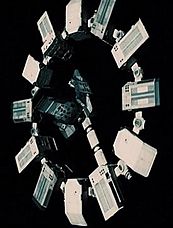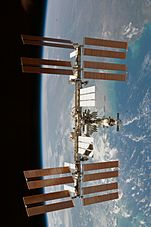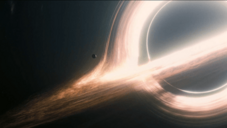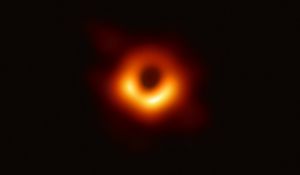Interstellar (film) facts for kids
Quick facts for kids Interstellar |
|
|---|---|
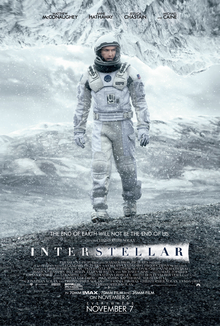
Theatrical release poster
|
|
| Directed by | Christopher Nolan |
| Produced by |
|
| Written by |
|
| Starring | |
| Music by | Hans Zimmer |
| Cinematography | Hoyte van Hoytema |
| Editing by | Lee Smith |
| Distributed by |
|
| Release date(s) | October 26, 2014 (TCL Chinese Theatre) November 5, 2014 (United States) November 7, 2014 (United Kingdom) |
| Running time | 169 minutes |
| Country |
|
| Language | English |
| Budget | $165 million |
| Money made | $773.8 million |
Interstellar is an exciting science fiction film from 2014. It was co-written, directed, and produced by Christopher Nolan. The movie stars famous actors like Matthew McConaughey, Anne Hathaway, and Jessica Chastain.
The story takes place in a future where Earth is struggling. A terrible plant disease, called a blight, has caused widespread famine. This means there isn't enough food for everyone. Humanity is facing extinction. To find a new home, a team of astronauts travels through a special shortcut in space called a wormhole, located near Saturn. They hope to find a new planet where humans can live.
Christopher Nolan and his brother Jonathan Nolan wrote the script. A famous physicist named Kip Thorne helped make sure the science in the movie was accurate. He even wrote a book about it called The Science of Interstellar. The film was shot using special cameras, including IMAX 70 mm, to create amazing visuals. Interstellar uses many real-life effects and miniature effects, with some digital effects added later.
The movie first showed in Los Angeles on October 26, 2014. It was a big success, earning over $773 million worldwide. Many scientists have praised it for how well it shows complex ideas like wormholes and black holes. Since its release, Interstellar has become a very popular film and is often called one of the best science-fiction films of all time. It even won an Academy Award for Best Visual Effects!
Contents
Exploring the Story of Interstellar
In the year 2067, Earth is in big trouble. A global famine, caused by environmental damage, threatens to wipe out humanity. Because of this, people have stopped exploring space. Joseph Cooper, a former NASA pilot, now works as a farmer.
One day, Cooper finds a strange message in his daughter Murph's bedroom. It leads him to a secret NASA facility. Here, Professor Brand explains that they are looking for a new planet that can support human life. Brand wants Cooper to pilot a spacecraft called the Endurance. This mission is humanity's last hope. The Endurance will travel through a wormhole near Saturn to another galaxy.
Journey Through the Wormhole
On the other side of the wormhole, the crew explores three planets. These planets orbit a giant supermassive black hole called Gargantua. Romilly stays in orbit to study Gargantua. Cooper, Amelia Brand (Professor Brand's daughter), and Doyle go to the first planet. This planet is covered in shallow water. They find that the explorer who came before them, Miller, is dead. Doyle is swept away by a huge tidal wave caused by Gargantua's gravity.
The wave also floods their ship's engines. They manage to dry them out and take off just in time. When they return to the Endurance, only one hour has passed for them. But because of the black hole's gravity, 23 years have gone by on Earth! Back home, Murph has grown up and become a scientist, working with Professor Brand.
Challenges and Discoveries
Next, the crew goes to a second planet. They wake up another explorer named Mann from frozen sleep. Mann tells Cooper that he lied about his planet being livable. He just wanted someone to rescue him. Meanwhile, back on Earth, Professor Brand is dying. He tells Murph that he also lied about being able to solve a gravity equation. He hoped Cooper's team would find a new planet where humans could start a colony using special fertilized eggs.
At Mann's camp, Romilly dies in an explosion. Mann tries to kill Cooper and steals a ship. He attempts to dock with the Endurance but ignores safety warnings and blows himself up. Cooper and Brand manage to save the damaged Endurance.
A New Hope for Humanity
With little hope left, Cooper comes up with a daring plan. They will use the remaining ships to slingshot around Gargantua. This will give them enough speed to reach the third and final planet. But Cooper has to sacrifice himself by falling into the black hole. This allows Amelia Brand to reach Edmunds' planet.
Instead of being crushed by the black hole, Cooper finds himself in a five-dimensional space called a tesseract. From here, he can see moments from Murph's childhood bedroom. He realizes that future humans created this space. He uses gravity to send messages in Morse code to Murph in the past. He gives her the information she needs to solve the gravity equation.
The future beings then return Cooper near Saturn, where he is rescued. He reunites with an elderly Murph, who has used his information to save humanity. She tells him to find Amelia. Cooper then sets off again to reunite with Amelia. On the final planet, Amelia takes off her helmet and breathes, confirming the planet can support life.
Main Characters in Interstellar
Here are some of the main actors and the characters they play:
- Matthew McConaughey as Joseph Cooper: A former NASA pilot who becomes a farmer. He leads the mission to find a new home.
- Anne Hathaway as Dr. Amelia Brand: A smart NASA scientist and astronaut. She is Professor Brand's daughter.
- Jessica Chastain as Murphy "Murph" Cooper: Joseph's daughter, who grows up to be a NASA scientist.
- Mackenzie Foy plays young Murph.
- Ellen Burstyn plays elderly Murph.
- Bill Irwin as TARS (voice and puppetry) and CASE (puppetry): These are the helpful robots on the mission.
- Michael Caine as Professor John Brand: A top NASA scientist and Amelia's father.
- Matt Damon as Mann: An astronaut sent on an earlier mission to an icy planet.
Making the Film: Production Details
Behind the Scenes Crew
- Christopher Nolan – Director, producer, writer
- Jonathan Nolan – Writer
- Emma Thomas – Producer
- Lynda Obst – Producer
- Hoyte van Hoytema – Cinematographer (in charge of filming)
- Nathan Crowley – Production designer (creates the look of the film)
- Lee Smith – Editor (puts the film together)
- Hans Zimmer – Music composer (writes the film's score)
- Paul Franklin – Visual effects supervisor
- Kip Thorne – Scientific consultant, executive producer
How the Idea for Interstellar Began
The idea for Interstellar came from producer Lynda Obst and physicist Kip Thorne. They had worked together before on the film Contact. They imagined a story where amazing space events become real for humans. Steven Spielberg was initially interested in directing it. In 2007, Jonathan Nolan was hired to write the script.
Later, Christopher Nolan joined the project in 2012. He met with Kip Thorne to discuss how spacetime could be used in the story. Christopher Nolan wanted the film to inspire people about human spaceflight. He combined his brother's script with his own ideas. To prepare, Nolan visited NASA and the private space company SpaceX.
Filming Locations and Secrets
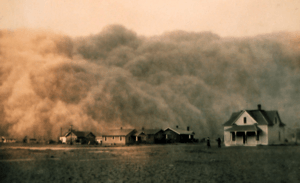
Christopher Nolan is known for keeping his film details a secret. Interstellar was filmed under the fake name Flora's Letter to keep things quiet. The main filming took about four months. It started in August 2013 in Alberta, Canada. For a scene showing a huge dust storm, the crew planted 500 acres of corn. They used large fans to create realistic dust clouds.
Filming also took place in Iceland. This country was chosen to look like two different alien planets: one covered in ice and another in water. The crew even brought mock spaceships weighing 10,000 pounds to Iceland! While filming a water scene there, Anne Hathaway almost got hypothermia because her special suit wasn't sealed properly. After Iceland, the crew spent 54 days filming in Los Angeles. The total budget for the film was $165 million.
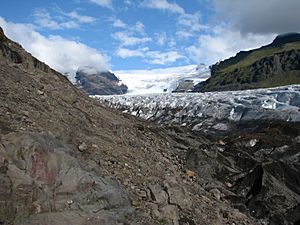
Designing the Spaceships and Robots
Interstellar features three main spacecraft: the Endurance, a Ranger, and a Lander. The Endurance is the main ship, shaped like a circle with 12 sections. Production designer Nathan Crowley said it was inspired by the International Space Station. He explained that every part of the ship has a purpose, like a submarine in space.
The Ranger ship is like a Space Shuttle, designed to enter and leave planet atmospheres. The Lander transports equipment to the planets. Crowley compared it to a "heavy Russian helicopter."
The film also has two unique robots, CASE and TARS. Nolan wanted them to look different from typical human-like robots. They have a special rectangular design. Bill Irwin controlled both robots physically, and his image was removed digitally. Josh Stewart provided the voice for CASE.
Sound and Music of Interstellar
Hans Zimmer, who composed music for Nolan's other films like Inception, created the score for Interstellar. Nolan gave Zimmer a simple story about a father leaving his child for work. This helped Zimmer create the emotional music. They decided to use a 1926 organ from the Temple Church in London as the main instrument for the score. Zimmer spent a lot of time perfecting the music. The soundtrack was released on November 18, 2014.
The film's sound was carefully designed to use theater equipment to its fullest. Some dialogue was intentionally made to sound muffled by background noise or music. This made it feel more realistic, like you were really in space.
Amazing Visual Effects
The company Double Negative, which worked on Inception, created the visual effects for Interstellar. Instead of using green screens, they projected digital effects behind the actors. This made the scenes feel more real. The film had 850 visual effect shots.
The spaceships like the Ranger, Endurance, and Lander were created using miniature effects, not just computer graphics. These models were huge, earning the nickname "maxatures." For example, a model of the Endurance module was over 25 feet long! IMAX cameras were even mounted directly onto these models to make them look like real spacecraft.
Inspirations for the Film
Nolan was inspired by classic science fiction films such as 2001: A Space Odyssey (1968) and Blade Runner (1982). He also looked at films like Steven Spielberg's Jaws (1975) and Close Encounters of the Third Kind (1977). He wanted Interstellar to be family-friendly but also exciting and thought-provoking.
Before filming, Nolan showed his crew The Right Stuff (1983), a movie about early astronauts. He also invited former astronaut Marsha Ivins to the set. Nolan and his team studied NASA IMAX documentaries to get ideas for how space missions look. The farm setting in the film was inspired by the early life of Clark Kent in Man of Steel.
Scientific Accuracy in Interstellar
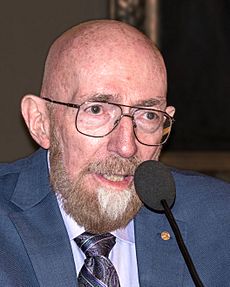
Kip Thorne, a theoretical physicist and Nobel Prize winner, was a scientific consultant for Interstellar. He made sure that nothing in the film broke known laws of physics. He also ensured that any wild ideas came from real science. For example, Thorne worked on equations to show how light would travel through a wormhole or around a black hole. This means what you see in the movie is based on Einstein's general relativity equations.
Thorne did have to convince Nolan not to have a character travel faster than light, as this is not possible in real physics. One part of the film that takes some artistic freedom is the giant ice clouds on one of the planets. These structures would likely not be able to hold together in reality.
Other scientists have also commented on the film's accuracy. Neil deGrasse Tyson, an astrophysicist, said that interacting with the past, as seen in the film's ending, is theoretically possible. The theoretical physicist Michio Kaku praised the film for its scientific accuracy.
Wormholes and Black Holes in the Film
To create the visual effects for the wormhole and the rotating black hole called Gargantua, Kip Thorne worked with a team of 30 people. He gave them complex physics equations. The team then wrote new computer software to create accurate simulations of how light would bend around these objects. Some single images took up to 100 hours to create!
The visual effects helped Thorne gain new insights into black holes, leading to the publication of three scientific papers. Nolan was initially worried that a scientifically accurate black hole might be too hard for audiences to understand. However, he found that the final effect was clear.
The way the black hole's accretion disk (the ring of material around it) looks in the film is very similar to the first real image of a black hole's event horizon, taken in 2019. This shows how accurate the film's science was.
According to Space.com, the film's portrayal of a wormhole is also scientifically correct. Instead of a flat hole, it's shown as a sphere, giving a distorted view of the galaxy on the other side.
Promoting Interstellar
The first preview for Interstellar came out in December 2013. It showed clips about space exploration with a voiceover from Matthew McConaughey's character. A longer trailer was released in May 2014 and quickly became the most-watched film trailer online.
Christopher Nolan and Matthew McConaughey promoted the film at San Diego Comic-Con in July 2014. Paramount Pictures also launched an interactive website where users could explore a star chart related to the Apollo 11 Moon landing.
In October 2014, Paramount partnered with Google to promote the film. The film's website became a digital hub with a game where players could build Solar System models and use a space flight simulator. This partnership also included a virtual time capsule and used the film to promote math and science in schools.
Paramount offered a virtual reality experience of the Endurance spacecraft using Oculus Rift technology. Several books were also released, including Interstellar: Beyond Time and Space about the making of the film, and The Science of Interstellar by Kip Thorne. A comic book prequel called Absolute Zero was also released, telling the story of the character Mann.
Release of Interstellar
In Theaters
Interstellar first premiered in Los Angeles on October 26, 2014, and in London on October 29. It was released early in North America on November 4 in special film formats like 70 mm IMAX and 35 mm film. It then had a wider release on November 7 in digital theaters.
Christopher Nolan wanted the film to be shown on traditional film stock, even though most theaters had switched to digital. This helped preserve the older film format. Paramount Pictures distributed the film in North America, and Warner Bros. distributed it internationally. The film was shown on over 770 IMAX screens worldwide, making it one of the biggest IMAX releases at the time.
Watching at Home
Interstellar was released for home viewing on March 31, 2015, in both the United Kingdom and the United States. It was a top seller for two weeks. It was later released in Ultra HD Blu-ray format on December 19, 2017.
See also
 In Spanish: Interstellar para niños
In Spanish: Interstellar para niños
- Black holes in fiction
- Blanet – a planet orbiting a black hole
- Causal loop
- Interstellar travel
- List of American films of 2014
- List of British films of 2014
- List of films featuring drones
- List of films featuring space stations
- List of time travel works of fiction
- Starship
- Wormholes in fiction




